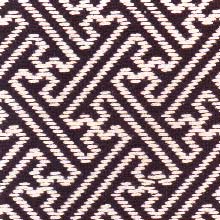Weave (p. 34 )
1. Produced in Hirosaki City, Aomori Prefecture.
2. Characteristics: A hemp cloth dyed in indigo on which varieties of geometrical patterns are stitched with white cotton threads. The stitches are for reinforcing the cloth and for warm keeping. The contrast in the color of indigo and white and the beauty of the orderly patterns have great appeal to the men today.
3. Uses: Once used mainly for work garments, it is used today for many other items such as sashes, wallets, handbags, neckties, wall carpets "noren"(shop curtain) cigarette cases, table centers, etc.
4. History: The only type of cloth farmers were allowed to use was hemp. As the hemp cloths were not strong, the farmers reinforced the cloths by dyeing them with indigo and by stitching them with the threads taken from the stems of a grass called "Choma"(or Karamushi ,Bochimeria nipononivea, same species as ramie). After the Meiji Period(1868-1912) when cotton became more available, it replaced the hemp and cotton was used both for the cloth and for the stitching. This is an example of how some farmers invented a new technique in spite of very poor living conditions.



